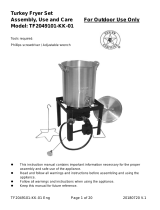1. Never leave the appliance unattended. Keep children and pets away from
the appliance at all times.
2. The use of alcohol, prescription or non-prescription drugs may impair the
consumer’s ability to properly assemble or safely operate the appliance.
3. This appliance is for OUTDOOR USE ONLY. DO NOT use in a building,
garage or any other enclosed area. This appliance is not intended to be
installed in or on a recreational vehicle and/or boat. This appliance is not
intended for and should never be used as a heater.
4. This appliance must not be used on or under any apartment or
condominium balcony or deck.
5. When cooking, the fryer/boiler must be on a level, stable noncombustible
surface in an area clear of combustible material. As asphalt surface
(blacktop) may not be acceptable for this purpose.
6. When cooking with oil or grease, the thermometer provided MUST be
used. Follow instructions in this manual for proper installation and use of
the thermometer. If the thermometer supplied with this fryer has been lost
or damaged, a replacement thermometer must be one specified by the
appliance manufacturer.
7. If the temperature exceeds 400°F (200°C) or if oil begins to smoke,
immediately turn the burner or gas supply OFF and wait for the
temperature to decrease to less than 350°F (175°C) before relighting
burner according to the manufacturer’s instructions. If there is a lid
(cover), do not remove the lid.
8. When cooking with oil or grease, have a type BC or ABC fire extinguisher
readily available. In the event of an oil or grease fire do not attempt to
extinguish with water. Immediately call the fire department. A Type BC or
ABC fire extinguisher may in some circumstances contain the fire.
9. Never overfill the cooking vessel with oil, grease or water. If the vessel
doesn’t indicate the maximum fill line, please refer to following instructions
for determining the maximum fill level.
Determining the maximum fill level when using a vessel without a
maximum line:
(1) Place the food product in the basket.
(2) Place the food product and holder into the empty vessel.
(3) Fill the vessel with water just until the food product is completely

























